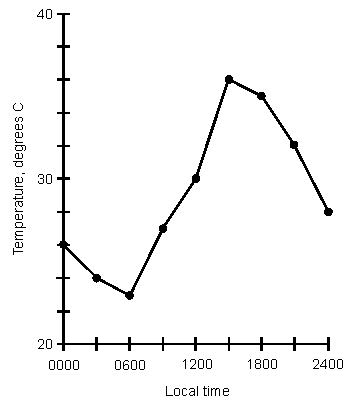point-to-point graph (line graph)
A point-to-point graph, also called a line graph, is a pictorial rendition of data in which specific values of a function are plotted as dots on a coordinate plane. Adjacent pairs of dots are connected by straight lines. In most point-to-point graphs, the independent variable is rendered along the horizontal axis with values increasing from left to right. The dependent variable is rendered along the vertical axis with values increasing from the bottom up.

The illustration is a point-to-point graph showing the temperature in degrees Celsius as a function of the local time in a fictitious town over the 24-hour period representing a hypothetical midsummer day. Temperature readings, accurate to the nearest degree, are taken at 0000 hours (midnight), 0300 hours (3:00 a.m.), 0600 hours (6:00 a.m.), 0900 hours (9:00 a.m.) and so on at 3-hour intervals until the following midnight. The results are plotted as points. Finally, each adjacent pair of points is connected by a solid, straight line segment.
Point-to-point graphs are commonly used for portraying functions in which time is the independent variable. A point-to-point graph may be superimposed on a bar graph in a specialized plot called a Pareto chart . Some point-to-point graphs allow plotting of functions having multiple dependent variables, positive/negative variables and multi-category variables.
Compare pie graph .